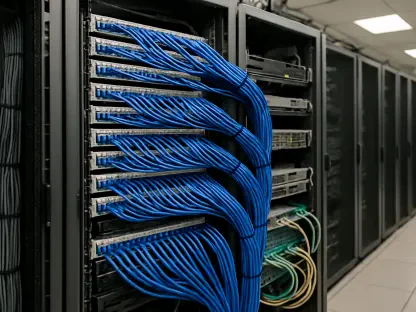In the rapidly evolving landscape of cloud-native computing, organizations have embraced a transformative approach to software development, leveraging microservices, APIs, and automated pipelines to achieve unprecedented speed and scalability. However, this paradigm shift has unveiled a profound vulnerability at the heart of modern IT systems: the software supply chain. As traditional network perimeters fade into obsolescence, the intricate web of code dependencies, build systems, and third-party components has become the new frontier for cybersecurity threats. This critical weakness raises pressing questions about the security of cloud-native environments, where a single breach can cascade through interconnected systems with devastating impact. Exploring the inherent risks, industry responses, and broader implications, this discussion delves into whether supply chain security truly represents the most significant chink in the armor of cloud-native architectures, challenging businesses to rethink their approach to trust and resilience in a distributed digital world.
Redefining the Security Landscape
The era of relying solely on firewalls and endpoint defenses to protect organizational assets has long passed, as cloud-native environments have fundamentally altered the security paradigm. With applications now built on distributed systems that span countless dependencies and automated processes, the software supply chain has emerged as the primary target for malicious actors. Every element, from open-source libraries to CI/CD pipelines, poses a potential risk, as attackers increasingly exploit these interconnected components to infiltrate systems. High-profile breaches have demonstrated the fragility of these chains, revealing how a single compromised link can jeopardize entire ecosystems. Securing this new perimeter is not merely a technical necessity but a foundational requirement for maintaining trust in digital operations, as organizations grapple with the reality that traditional security measures are no longer sufficient in a world of boundless connectivity and rapid deployment.
Moreover, the shift to a supply chain-focused security model demands a reevaluation of how risks are identified and mitigated in cloud-native settings. Unlike the static boundaries of past IT architectures, today’s systems are dynamic, with components sourced from diverse origins and integrated at breakneck speed. This complexity makes it challenging to maintain visibility over every piece of code or tool in use, often leaving gaps that attackers can exploit. The emphasis must now be on proactive measures that ensure integrity at every stage of the software lifecycle, from development to deployment. Without robust mechanisms to verify and secure these elements, organizations risk catastrophic failures that can undermine customer confidence and operational stability. As the attack surface expands, understanding and addressing these vulnerabilities becomes paramount to safeguarding the future of cloud-native innovation.
Unpacking Systemic Risks in Cloud-Native Systems
Cloud-native architectures are celebrated for their agility and collaborative nature, enabling developers to build and deploy at unparalleled speeds, but these very attributes introduce significant security challenges. Dependency sprawl, where applications rely on numerous third-party and open-source libraries, often leads to outdated or malicious code slipping through the cracks. Compromised build processes and untracked contributions from shadow IT or AI-driven tools further compound the problem, creating hidden vulnerabilities. The fast-paced nature of development cycles frequently prioritizes delivery deadlines over thorough security checks, leaving systems exposed to threats that can propagate across interconnected networks. These systemic issues highlight a critical flaw in cloud-native design, where the drive for efficiency can inadvertently weaken the foundation of security.
Beyond the technical pitfalls, the cultural dynamics within development teams often exacerbate supply chain risks in cloud-native environments. The pressure to innovate quickly can lead to oversight, where security is treated as an afterthought rather than a core component of the process. Developers may unknowingly integrate vulnerable components, assuming trust in widely used libraries or tools without rigorous validation. Additionally, the lack of centralized oversight over code sources means that rogue elements can enter the pipeline undetected, amplifying the potential for widespread damage. Addressing these ingrained habits requires not only technological solutions but also a fundamental shift in mindset, ensuring that security is woven into the fabric of development practices. Only through such comprehensive efforts can the inherent weaknesses of cloud-native supply chains be mitigated.
Industry Innovations and Regulatory Push
As the threats to software supply chains in cloud-native environments escalate, the tech industry has responded with a wave of innovative tools and frameworks aimed at restoring integrity and trust. Solutions like Sigstore, which enables keyless signing and provenance tracking, alongside SLSA (Supply-chain Levels for Software Artifacts), a model for assessing build maturity, are paving the way for more secure practices. Software Bill of Materials (SBOMs) offers transparency by cataloging dependencies, while regulatory mandates like the U.S. Executive Order on Cybersecurity and the EU’s Cyber Resilience Act compel organizations to prioritize supply chain safeguards. These developments reflect a growing consensus that standardization and accountability are essential to countering the sophisticated threats facing distributed systems, marking a pivotal step toward a more resilient digital landscape.
However, the adoption of these tools and standards is only part of the solution, as their effectiveness hinges on widespread implementation and continuous refinement. Many organizations struggle to integrate complex frameworks into existing workflows, often lacking the resources or expertise to fully leverage tools like SBOMs for comprehensive visibility. Regulatory pressures, while necessary, can sometimes lead to a checkbox mentality, where compliance is achieved on paper but not in practice, leaving gaps in actual security. The industry must focus on fostering collaboration between vendors, developers, and policymakers to streamline these initiatives and ensure they address real-world challenges. By aligning technical innovation with enforceable standards, the collective effort to secure supply chains can gain the momentum needed to outpace evolving cyber threats.
The Broader Impact on Business and Culture
Supply chain security in cloud-native environments transcends the realm of IT, emerging as a critical concern for business leaders at the highest levels. A breach in the supply chain can have far-reaching consequences, eroding customer trust, triggering regulatory penalties, and damaging organizational reputation. The ripple effects can even impact executive careers, as accountability for such failures often falls on leadership. This reality underscores the need to elevate supply chain security to a boardroom priority, where strategic decisions reflect the importance of safeguarding digital assets. Trust in software is the bedrock of modern business, and failing to protect it risks not only financial loss but also the long-term viability of operations in an increasingly interconnected market.
Equally important is the cultural transformation required to embed security into the DNA of an organization. Responsibility for supply chain integrity cannot rest solely with IT or security teams; it must be shared across developers, operators, product managers, and even legal departments. This collective ownership demands a shift in perspective, where security is seen as an integral part of innovation rather than a barrier to progress. Training programs, clear policies, and cross-functional collaboration are vital to fostering this mindset, ensuring that every stakeholder understands their role in protecting the supply chain. By aligning business objectives with security imperatives, organizations can build a culture of resilience that supports sustainable growth in the cloud-native era.
Navigating the Roadblocks to Secure Implementation
Even with advanced tools and growing regulatory focus, securing the software supply chain in cloud-native systems remains a formidable challenge due to practical and operational hurdles. The complexity of managing detailed SBOMs often overwhelms teams, especially in large-scale environments with countless dependencies to track. Fragmented standards and a proliferation of tools can create confusion, as organizations struggle to align disparate solutions into a cohesive strategy. Developer fatigue is another significant barrier, as additional security protocols are perceived as slowing down delivery timelines, leading to resistance or incomplete adoption. These obstacles reveal that achieving robust supply chain security is not a one-time achievement but a continuous process requiring persistent effort and adaptation to evolving threats.
Furthermore, there’s a subtle yet dangerous tendency to equate compliance with genuine security, which can lull organizations into a false sense of safety. Meeting regulatory requirements or implementing a toolset does not guarantee protection if underlying vulnerabilities or human errors persist. Addressing this gap necessitates a focus on actionable outcomes rather than superficial metrics, ensuring that security measures are both effective and sustainable. Investment in training and automation can help alleviate some burdens, enabling teams to manage complexity without sacrificing speed. As the journey toward secure supply chains unfolds, organizations must remain vigilant, recognizing that each step forward, no matter how small, builds toward a stronger defense against the ever-present risks in cloud-native architectures.
Building a Resilient Future
Reflecting on the challenges and solutions discussed, it becomes evident that supply chain security stands as a defining vulnerability in cloud-native environments, demanding urgent and sustained attention. The systemic risks embedded in dependency sprawl and rapid development cycles have exposed organizations to significant threats, often amplified by past high-profile breaches that shook industry confidence. While tools like Sigstore and SLSA, alongside regulatory frameworks, offer promising pathways to mitigation, the hurdles of complexity and cultural resistance have slowed progress. Looking ahead, the focus must shift to actionable strategies—integrating provenance tracking, operationalizing SBOMs, and fostering a security-first mindset across all levels of an organization. By prioritizing supply chain integrity as a cornerstone of digital trust, businesses can chart a course toward resilience, ensuring that the benefits of cloud-native innovation are not undermined by preventable weaknesses.









